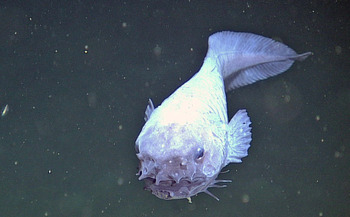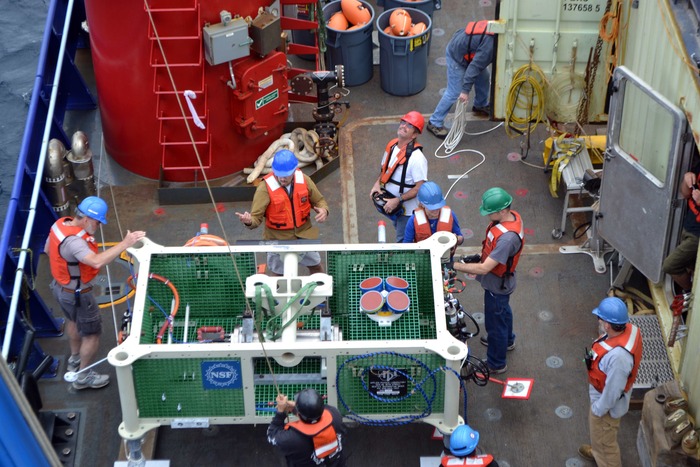
This strange fish, Genioliparis ferox (Stein), was first described in 1978 from a single specimen and never seen afterwards. It was imaged at 2901 m at the Slope Base Site during ROPOS Dive R1757. G. ferox is a ferocious mid-water predator, with many sharp teeth.
Photo Credit: NSF-OOI/UW/CSSF; Dive R1757; V14
The NE Pacific weather goddess was not kind to us the past ~24 hrs. In the wee hours of the morning yesterday, we began a 20 hour transit under angry seas to the Slope Base site, ~ 80 km west of Newport Oregon. With five Jason dives in about 36 hrs, the team was happy to have the transit time to catch up on sleep, the intense documentation required for keeping track of all operations and instrument status upon recovery, and daily operational reports.
When we arrived on site a bit after midnight, the seas were too rough to safely put the vehicle in the water so two, full ocean depth CTD (conductivity, temperature, depth) water casts were completed to obtain water samples to be used for installation of the HPIES instruments on Leg 2 of this cruise.
Alas, a high sea state remained during the day with a low pushed up against the coast. However, during the early evening the seas dampened and Jason went into the water at ~ 9 pm for Dive J913 with the low-power junction box latched beneath its underbelly for its ~ 3 hour transit to the seafloor.
Of special note, almost immediately upon reaching the seafloor at 2900 m (~9500 ft) we saw our old friends fondly called ‘weird fish’, with a formal name of Genioliparis ferox. It is distinctive because of its very large head and massive jaw – it is voracious. This is the third year that we have seen this fish at this site. Prior to our observations of it in 2014, it had never been filmed before. These fish have only rarely been observed, with most sightings off of Antarctica.
During the dive, Jason installed the new junction box and connected it. But over the dive, the seas again worsened again. It was determined that the junction box installed in 2015, should be left on the seafloor for recovery on a follow-on dive subsequent to installation of the Shallow Profiler Science Pod at this site. Jason transited to the base of the Shallow Profiler Mooring for a close inspection of the >3000 m long thick chain that forms the southern leg, which helps hold the mooring in place, secured by a 12,000 lb anchor on the seafloor. Close inspection showed that the leg was in very good shape – free of corrosion and signs of wear. With worsening seas, Jason began its transit to the surface, where it was safely recovered.
During the evening and through the morning today, the science team anxiously awaited the seas to flatten – finally, this afternoon the seas smoothed out and Jason returned to the ocean depths to continue our work out here…..onward we go. Skip Denny, our Lead Engineer from the Applied Physics Laboratory and onboar weather man, has promised us good weather for the rest of Leg 1.



